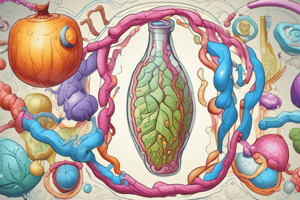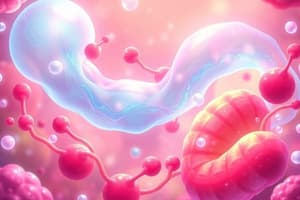Podcast
Questions and Answers
What stimulates the release of triacylglycerol from adipose tissue?
What stimulates the release of triacylglycerol from adipose tissue?
Glucagon and epinephrine stimulate the release of triacylglycerol by activating hormone-sensitive lipase (HSL).
What are the main types of fatty acid oxidation?
What are the main types of fatty acid oxidation?
The main types of fatty acid oxidation are α-oxidation, β-oxidation, and ω-oxidation.
Describe the carnitine shuttle's role in fatty acid oxidation.
Describe the carnitine shuttle's role in fatty acid oxidation.
The carnitine shuttle facilitates the transport of activated long-chain fatty acids into the mitochondria for β-oxidation.
What is β-oxidation, and where does it take place?
What is β-oxidation, and where does it take place?
Explain how α-oxidation differs from β-oxidation.
Explain how α-oxidation differs from β-oxidation.
What is the significance of ketogenesis, and under what conditions does it occur?
What is the significance of ketogenesis, and under what conditions does it occur?
What is Refsum’s disease, and what is its biochemical basis?
What is Refsum’s disease, and what is its biochemical basis?
How do glucagon and insulin influence triacylglycerol metabolism?
How do glucagon and insulin influence triacylglycerol metabolism?
What is the consequence of CPT-I deficiency in fatty acid metabolism?
What is the consequence of CPT-I deficiency in fatty acid metabolism?
How does myopathic carnitine deficiency affect muscle function?
How does myopathic carnitine deficiency affect muscle function?
Explain the role of Acyl CoA dehydrogenase in fatty acid β-oxidation.
Explain the role of Acyl CoA dehydrogenase in fatty acid β-oxidation.
What is the significance of malonyl CoA in regulating fatty acid metabolism?
What is the significance of malonyl CoA in regulating fatty acid metabolism?
Describe the impact of Medium chain acyl CoA dehydrogenase (MCAD) deficiency on metabolism.
Describe the impact of Medium chain acyl CoA dehydrogenase (MCAD) deficiency on metabolism.
What are the initial substrates and products of the reaction catalyzed by propionyl CoA carboxylase?
What are the initial substrates and products of the reaction catalyzed by propionyl CoA carboxylase?
How is fatty acyl carnitine involved in the regulation of pyruvate dehydrogenase?
How is fatty acyl carnitine involved in the regulation of pyruvate dehydrogenase?
What metabolic consequences arise from omega oxidation?
What metabolic consequences arise from omega oxidation?
What is the role of acetyl CoA carboxylase in fatty acid synthesis?
What is the role of acetyl CoA carboxylase in fatty acid synthesis?
Describe the process of ketogenesis and its connection to fatty acid metabolism.
Describe the process of ketogenesis and its connection to fatty acid metabolism.
Explain the significance of malonyl CoA in fatty acid synthesis.
Explain the significance of malonyl CoA in fatty acid synthesis.
What are the implications of acetyl CoA carboxylase deficiency?
What are the implications of acetyl CoA carboxylase deficiency?
How are very long chain fatty acids oxidized in peroxisomes?
How are very long chain fatty acids oxidized in peroxisomes?
What is the major output of the fatty acid synthesis process?
What is the major output of the fatty acid synthesis process?
How does citrate influence fatty acid synthesis?
How does citrate influence fatty acid synthesis?
What is the primary function of fatty acid synthase in lipid metabolism?
What is the primary function of fatty acid synthase in lipid metabolism?
What are ketone bodies and when are they utilized by the body?
What are ketone bodies and when are they utilized by the body?
How does the body handle energy production from Free Fatty Acids?
How does the body handle energy production from Free Fatty Acids?
What role does biotin play in lipid metabolism?
What role does biotin play in lipid metabolism?
Explain the consequence of high CHO diets on fatty acid metabolism.
Explain the consequence of high CHO diets on fatty acid metabolism.
What structural features distinguish triacylglycerols in fat storage?
What structural features distinguish triacylglycerols in fat storage?
Flashcards
Fatty Acid Oxidation
Fatty Acid Oxidation
The breakdown of fatty acids to produce energy.
β-Oxidation
β-Oxidation
The main pathway for fatty acid breakdown in mitochondria.
Carnitine Shuttle
Carnitine Shuttle
Mechanism that transports fatty acids from the cytoplasm to the mitochondria.
Ketogenesis
Ketogenesis
Signup and view all the flashcards
Triacylglycerol (TAG) Release
Triacylglycerol (TAG) Release
Signup and view all the flashcards
α-Oxidation
α-Oxidation
Signup and view all the flashcards
Peroxisomal β-oxidation
Peroxisomal β-oxidation
Signup and view all the flashcards
Hormone-Sensitive Lipase (HSL)
Hormone-Sensitive Lipase (HSL)
Signup and view all the flashcards
Carnitine shuttle
Carnitine shuttle
Signup and view all the flashcards
CPT-I deficiency
CPT-I deficiency
Signup and view all the flashcards
Beta-oxidation
Beta-oxidation
Signup and view all the flashcards
MCAD deficiency
MCAD deficiency
Signup and view all the flashcards
Propionyl CoA
Propionyl CoA
Signup and view all the flashcards
Propionyl CoA carboxylase
Propionyl CoA carboxylase
Signup and view all the flashcards
Methylmalonyl CoA mutase
Methylmalonyl CoA mutase
Signup and view all the flashcards
Acyl-CoA dehydrogenase
Acyl-CoA dehydrogenase
Signup and view all the flashcards
β-oxidation in peroxisomes
β-oxidation in peroxisomes
Signup and view all the flashcards
Zellweger syndrome
Zellweger syndrome
Signup and view all the flashcards
Ketogenesis
Ketogenesis
Signup and view all the flashcards
Ketone bodies
Ketone bodies
Signup and view all the flashcards
Acetyl CoA carboxylase
Acetyl CoA carboxylase
Signup and view all the flashcards
Malonyl CoA
Malonyl CoA
Signup and view all the flashcards
Fatty acid synthesis
Fatty acid synthesis
Signup and view all the flashcards
Fatty acid synthase
Fatty acid synthase
Signup and view all the flashcards
Acetyl CoA carboxylase deficiency
Acetyl CoA carboxylase deficiency
Signup and view all the flashcards
Fatty acid elongation
Fatty acid elongation
Signup and view all the flashcards
Fatty acid desaturation
Fatty acid desaturation
Signup and view all the flashcards
Triacylglycerol (TAG) synthesis
Triacylglycerol (TAG) synthesis
Signup and view all the flashcards
Glycerol-3-phosphate
Glycerol-3-phosphate
Signup and view all the flashcards
TCA Cycle
TCA Cycle
Signup and view all the flashcards
Succinyl CoA
Succinyl CoA
Signup and view all the flashcards
Carboxylation of AcCoA
Carboxylation of AcCoA
Signup and view all the flashcards
Study Notes
Lipid Metabolism Overview
- Lipid metabolism encompasses the catabolism (breakdown) and anabolism (synthesis) of triacylglycerols (TAGs), fatty acids, and other lipids.
- Key objectives include understanding the major pathways of TAG metabolism, including oxidation (catabolism), ketogenesis, biosynthesis, storage, and phospholipid synthesis.
- Oxidation pathways include α-oxidation, β-oxidation, and ω-oxidation, occurring in both mitochondria and peroxisomes.
- Ketogenesis is the process of producing ketone bodies from fatty acids, important for energy production during times of glucose scarcity.
- Lipid synthesis involves the formation of fatty acids, triglycerides, and various phospholipids.
- Storage of triacylglycerols (TAGs) is a crucial function for long-term energy reserves in adipose tissue.
- Hormonal regulation plays a critical role in controlling TAG breakdown and synthesis. Insulin promotes storage, while glucagon and epinephrine stimulate breakdown.
Oxidation of Fatty Acids
- Fatty acid oxidation is a catabolic process characterized by the breakdown of fatty acids for energy production.
- This process proceeds through a cyclical mechanism known as Beta-oxidation.
- The process frequently starts by activating fatty acids into their coenzyme A derivatives (acyl-CoA) in the cytosol.
- Fatty acids are then transported into the mitochondria via the carnitine shuttle.
- Beta-oxidation takes place within the mitochondrial matrix and produces reduced electron carriers (NADH and FADH2) and acetyl-CoA.
- The acetyl-CoA enters the citric acid cycle for further energy production.
- Peroxisomal beta-oxidation pathway exists, utilizing different enzymes and differing in some aspects from mitochondrial beta-oxidation.
Ketogenesis
- Ketogenesis is a metabolic pathway that is important during periods of reduced carbohydrate availability.
- Primarily involves the conversion of fatty acids to ketone bodies in the liver.
- Key ketone bodies include acetoacetate, beta-hydroxybutyrate, and acetone.
- These ketone bodies are transported to other tissues such as the brain and heart which utilize the ketone bodies as an alternate substrate for energy production.
Lipid Synthesis
- Lipid synthesis involves the creation of fatty acids, triglycerides, and various phospholipids.
- Acetyl-CoA, a product of glucose metabolism, plays a central role in fatty acid synthesis.
- The process, often occurring in the cytosol, involves acetyl-CoA carboxylase to convert Acetyl-CoA to Malonyl-CoA.
- Fatty acid synthase complex is a key enzyme in the synthesis pathway.
Triacylglycerol (TAG) Synthesis
- TAG synthesis involves the esterification of glycerol with fatty acids.
- Glycerol-3phosphate is a crucial intermediate.
- The synthesis process uses fatty acids as core components, along with glycerol, which can be derived from glucose.
- TAGs are stored in adipose tissues for long-term energy storage.
Phospholipid Synthesis
- Phospholipids are crucial components of cell membranes.
- Phosphatidic acid is a precursor for several phospholipids.
- Various pathways exist to create different phospholipids.
- This process leads to the formation of cardiolipin and other molecules for various actions in bodily functions.
Regulation of Lipid Metabolism
- Lipid metabolism is tightly regulated to maintain homeostasis.
- Hormonal regulation like insulin and glucagon are key factors.
- Other factors like citrate, malonyl CoA, and fatty acyl CoA play crucial roles as regulators.
Diseases Related to Lipid Metabolism
- Defects in various enzymes or transport proteins can lead to serious metabolic disorders.
- Examples include Refsum's disease, Medium-chain acyl-CoA dehydrogenase deficiency (MCADD) and Zellweger syndrome.
Important Vitamins
- Important vitamins play a crucial role in lipid metabolism, particularly B vitamins
Studying That Suits You
Use AI to generate personalized quizzes and flashcards to suit your learning preferences.




